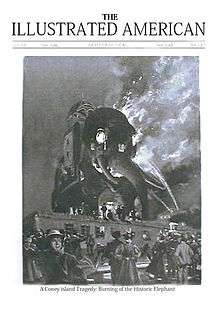Elephantine Colossus
The Elephantine Colossus (also known as the Colossal Elephant or the Elephant Colossus, or by its function as the Elephant Hotel) was a tourist attraction located on Coney Island in Brooklyn, New York City. It was built in the shape of an elephant, an example of novelty architecture. The seven story structure designed by James V. Lafferty stood above Surf Avenue and West 12th Street from 1885 until 1896, when it burnt down in a fire. During its lifespan, the thirty-one room building acted as a concert hall and amusement bazaar. It was the second of three elephant buildings built by Lafferty, preceded by the extant Lucy the Elephant near Atlantic City and followed by The Light of Asia in Cape May.

Size

At 122 feet tall, the Coney Island Elephant was approximately twice the size of Lucy the Elephant, which had pre-dated it by four years; with the exception of the designs of their respective howdahs and the numbers and relative sizes of the windows, externally it was a nearly exact scaled-up copy of Lucy. Its legs were 18 feet in diameter, with the front legs serving as a cigar store while the back legs held the entrance, a circular stairway. Construction was reported to have cost $65,000.[1] Built two years before the Statue of Liberty, it was said to be the first artificial structure visible to immigrants arriving to the United States.[2]
Construction required 3,500,000 feet of lumber, 11,000 kegs of nails, 12 tons of iron bolts and 57,000 square feet of tin to cover the structure.[3]
Rooms and attractions
Originally intended to serve as a tourist attraction, the elephant contained novelty stalls, a gallery, a grand hall, and a museum in what would be the elephant's left lung. The elephant's eyes contained telescopes and acted as an observatory for visitors. Its manager claimed to see, from the elephant's back, Yellowstone Park, Rio de Janeiro, and Paris.[4]
As Coney Island became more established as a center of tourism and leisure, the elephant began to serve as a brothel as well.[5][6][7] When the elephant caught fire on September 27, 1896, it had not been used for several years.[5]
In popular culture

Cover from October 10, 1896 issue of The Illustrated American
The Colossus is featured in Victoria Thompson's 2000 mystery novel Murder on St. Mark's Place, about the murder of several call girls who may have been linked to the hotel.
See also
- Lucy the Elephant, a similar surviving beach attraction elephant in Margate, New Jersey
References
- Sideshow World
- QI E06 - Everything, Etc.
- McMahon, William (1988). The Story of Lucy the Elephant. Margate, N.J.: Save Lucy Committee, Inc. p. 40.
- "Coney Island's Big Elephant – Its Back nearly Two Hundred Feet Above the Ground". New York Times. May 30, 1885. p. 8. Retrieved April 10, 2018.
- Immerso, Michael (2002). "Chapter 3: The Elephant Colosus". Coney Island: The People's Playground. Rutgers University Press. pp. 38–42. ISBN 0-8135-3138-1.
- "The Strange History of Old Coney Island’s Elephant Hotel-Turned-Brothel" http://www.bkmag.com/2015/07/06/the-strange-history-of-old-coney-islands-elephant-hotel-turned-brothel/
- "Was There Ever a Hotel for Prostitutes, Shaped Like a Giant Elephant?" https://www.nyhistory.org/community/elephantine-colossus
External links
- Shapes of Time on Coney Island, with pictures of the Elephant Hotel.
.jpg)
